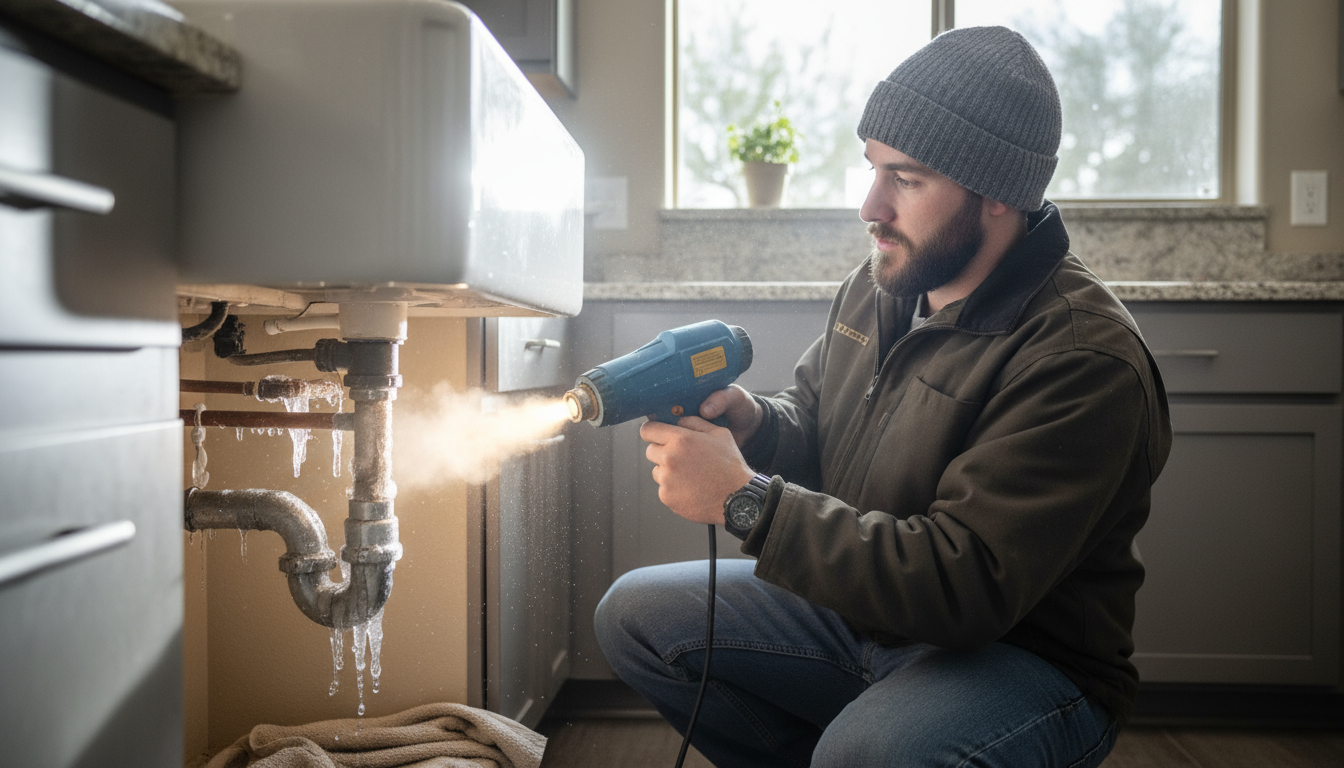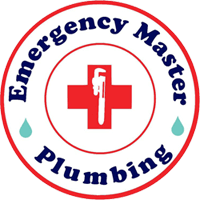

Winter in Arizona might not bring the heavy snow and subzero temperatures of other states, but even our milder cold snaps can catch homeowners off guard. With nighttime lows dipping into the 20s or lower in places like Phoenix, Flagstaff, or Tucson, frozen pipes remain a real risk. A burst pipe from freezing can lead to thousands of dollars in water damage, mold growth, and costly repairs. If you’re searching for “what to do when your pipes freeze in winter Arizona,” this guide provides step-by-step solutions tailored to our desert climate. Drawing from years of plumbing expertise, we’ll cover signs of trouble, immediate fixes, and long-term prevention strategies to keep your home safe and dry.
As licensed plumbers serving Arizona families, we’ve seen how quickly a chilly night can turn into a plumbing emergency. Understanding the unique factors—like our dry air and occasional freezes—helps you act fast and minimize damage. Let’s dive into the essentials.
Why Do Pipes Freeze in Arizona Winters?
Arizona’s winters are generally mild, with average lows around 40°F in the Valley and colder in higher elevations. However, sudden cold fronts or uninsulated pipes exposed to the elements can still cause water inside pipes to expand and freeze. When water freezes, it increases in volume by about 9%, putting immense pressure on pipe walls—up to 2,000 pounds per square inch. This can crack PVC, copper, or PEX lines, leading to leaks or bursts once the ice thaws.
In Arizona, the problem often stems from:
- Exposed Outdoor Pipes: Homes with hoses, sprinklers, or exterior faucets left uninsulated face the highest risk. Our sunny days followed by cool nights create temperature swings that exacerbate freezing.
- Poor Insulation in Crawl Spaces or Attics: Pipes running through unheated areas, common in older Arizona homes built for hot climates, cool rapidly during rare freezes.
- Wind and Dry Air: Unlike humid regions, Arizona’s low humidity means less natural insulation from frost, and gusty winds can drop effective temperatures further.
According to the Insurance Information Institute, frozen pipes cause one in 15 property damage claims nationwide, and while Arizona sees fewer incidents than northern states, events like the 2021 cold snap reminded us of the vulnerability. Homeowners in mobile homes or properties with slab foundations are particularly at risk if pipes run near exterior walls. Recognizing these causes empowers you to protect your plumbing before issues arise.
Signs Your Pipes Are Freezing in Arizona
Catching a freeze early prevents disaster. Watch for these warning signs, especially during Arizona’s winter months from December to February when overnight lows can surprise you:
- No Running Water: If faucets in sinks, showers, or toilets produce little to no flow, ice may be blocking the line. Test multiple fixtures—frozen pipes often affect isolated sections first.
- Frost or Bulging Pipes: Check visible pipes in cabinets, garages, or outdoors. Frost on the surface or unusual swelling indicates ice buildup. In Arizona, this might appear after a night below 32°F.
- Strange Noises: Dripping sounds from walls or ceilings could signal a small leak from cracking ice. Gurgling drains or banging in the pipes as water tries to move past obstructions are common red flags.
- Water Discoloration: When thawing begins, rusty or milky water might flow, indicating sediment disturbed by ice.
If you notice these in your Phoenix or Tucson home, don’t wait—delaying can lead to bursts. We’ve helped countless Arizona residents identify these signs during routine inspections, preventing major floods.
Immediate Steps: What to Do When Pipes Freeze
If your pipes freeze, act quickly but safely to thaw them and stop damage. Follow these Arizona-specific steps, keeping in mind our climate where freezes are short-lived but impacts can linger due to dry conditions.
1. Shut Off the Water Supply
Turn off your main water valve immediately to prevent flooding if a pipe bursts. Locate it near your water meter or where the supply enters your home—often in the garage or basement. In Arizona slab homes, it might be under a sink. If you’re unsure, avoid using water until help arrives.
For outdoor freezes common in our region, disconnect hoses and drain exterior lines by opening faucets. This step alone can save significant repair costs.
2. Thaw Pipes Safely
Use gentle heat to melt ice without risking further damage. Avoid open flames or high-heat tools, as they can warp pipes.
- Warm Water Method: Wrap frozen sections with towels soaked in hot (not boiling) water. Start at the faucet end and work toward the frozen area to direct melting flow outward.
- Space Heater or Hair Dryer: Apply low heat from a distance, moving along the pipe. Keep the room warm (above 55°F) to aid thawing. In Arizona’s mild winters, this often resolves issues within hours.
- Electrical Heating Cables: If installed, activate under-pipe heating tapes designed for cold climates—they’re safe and effective for Arizona’s occasional needs.
Never use torches; they violate safety codes and increase fire risks in our dry environment. Monitor for leaks as ice melts—if water sprays, shut off the supply again.
3. Assess and Contain Damage
Once thawed, inspect for cracks or leaks. Place buckets under drips and move valuables away from affected areas. In humid-free Arizona, mold growth is less immediate, but standing water can still damage floors and walls.
If a burst occurs, call professionals right away. DIY patches work for minor issues, but major breaks require expert tools to avoid recurring problems.
These actions, based on standard plumbing protocols from the American Society of Plumbing Engineers, have helped our team at Emergency Master Plumbing & Air resolve hundreds of winter emergencies in Arizona.
Preventing Frozen Pipes in Arizona Homes
Prevention is your best defense against Arizona’s sneaky winter chills. Implement these strategies year-round to safeguard your plumbing.
Insulate Vulnerable Pipes
Cover exposed pipes with foam sleeves or heat tape, available at local hardware stores. Focus on areas near windows, vents, and exterior walls—key trouble spots in Arizona ranch-style homes. For crawl spaces, add insulation blankets to keep ambient temperatures stable.
Maintain Indoor Temperatures
Keep your thermostat at 55°F or higher during cold nights. In Arizona, where days warm up quickly, use programmable thermostats to boost heat before freezes. Open cabinet doors under sinks to let warm air circulate around pipes.
Outdoor Precautions
Drain and winterize irrigation systems before November. Install insulating covers on outdoor faucets (frost-free models are ideal for Arizona). If you have a pool or spa, ensure pumps don’t run water through uninsulated lines at night.
Regular Maintenance Checks
Schedule annual plumbing inspections to identify weak points. In higher-elevation areas like Sedona or Prescott, where freezes are more frequent, check pipes monthly during winter. Seal gaps around pipes with caulk to block cold drafts.
Homeowners who follow these tips report far fewer incidents. For instance, insulating just the most exposed pipes can reduce freeze risk by up to 80%, per plumbing industry data.
Common Myths About Frozen Pipes in Arizona
Misinformation can lead to costly mistakes. Let’s debunk a few myths:
- Myth: Arizona Winters Are Too Mild for Freezes: While rare, events like the 2011 freeze damaged thousands of pipes statewide. Climate change is making cold snaps more unpredictable.
- Myth: Only Northern Pipes Burst: PVC pipes, popular in Arizona builds, are prone to cracking below 20°F, even briefly.
- Myth: Hot Water Pipes Are Safe: Both hot and cold lines can freeze if uninsulated; hot water lines often suffer more from rapid expansion.
Sticking to facts ensures effective protection.
When to Call Professional Plumbers in Arizona
Not every freeze requires a pro, but if you’re dealing with a burst pipe, widespread freezing, or an older home, expert help is essential. Signs you need immediate service include large leaks, no water restoration after thawing, or visible structural damage.
In Arizona, licensed plumbers use specialized tools like pipe cameras to detect hidden issues without invasive work. Delaying can lead to water loss bills from your utility or insurance claims—average repair costs range from $500 to $5,000.
Long-Term Solutions for Arizona Plumbing Resilience
For lasting peace of mind, consider upgrades like:
- PEX Piping: More flexible than copper, it resists freezing better and is code-compliant in Arizona.
- Smart Leak Detectors: Wi-Fi sensors alert you to issues via app, perfect for remote homeowners.
- Whole-Home Insulation Audits: Identify energy leaks that indirectly affect pipes.
These investments pay off, especially with Arizona’s growing population and variable weather.
In conclusion, while Arizona winters pose less freeze risk than elsewhere, vigilance is key. By recognizing signs, taking swift action, and preventing problems, you can avoid the hassle of frozen pipes. If you’re facing a potential issue or need a professional inspection, trust the experts who’ve been safeguarding Arizona homes for years.
For reliable, 24/7 emergency service tailored to our local climate, contact Emergency Master Plumbing & Air at 623-584-4706. Our team in Phoenix and surrounding areas responds quickly to thaw pipes, repair bursts, and prevent future worries—ensuring your home stays warm and functional all winter long.
